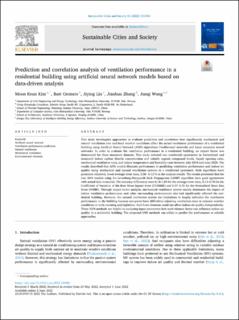| dc.contributor.author | Kim, Moon Keun | |
| dc.contributor.author | Cremers, Bart | |
| dc.contributor.author | Liu, Jiying | |
| dc.contributor.author | Zhang, Jianhua | |
| dc.contributor.author | Wang, Junqi | |
| dc.date.accessioned | 2022-10-06T10:25:53Z | |
| dc.date.available | 2022-10-06T10:25:53Z | |
| dc.date.created | 2022-07-25T15:55:29Z | |
| dc.date.issued | 2022-06-14 | |
| dc.identifier.citation | Sustainable Cities and Society (SCS). 2022, 83 . | en_US |
| dc.identifier.issn | 2210-6707 | |
| dc.identifier.issn | 2210-6715 | |
| dc.identifier.uri | https://hdl.handle.net/11250/3024285 | |
| dc.description.abstract | This study investigates approaches to evaluate prediction and correlation how significantly mechanical and natural ventilation rate and local weather conditions affect the actual ventilation performance of a residential building using Artificial Neural Network (ANN) algorithms: Feedforward networks and Layer recurrent neural networks. In order to evaluate the ventilation performance in a residential building, an impact factor was determined for these measured datasets. This study selected two residential apartments in Switzerland and measured indoor carbon dioxide concentration and volatile organic compound levels, façade opening ratio, mechanical ventilation rates, and indoor temperature and humidity ratio between July 2019 and June 2020. The results described that ANN models illustrate performance in predicting ventilation performance and indoor air quality using mechanical and natural ventilation systems in a residential apartment. Both algorithms have presented relatively lower average error rates, 3.36– 6.12 % in the analysis results. The results presented that the two ANN models using the Levenberg-Marquardt Back Propagation (LMBP) algorithm have good agreements with actual data measured. The accuracy differences were 0.18-1.89 for the average error rates, 0.13–0.78 for the Coefficient of Variation of the Root Mean Square Error (CVRMSE) and 0.07–0.35 for the Normalized Mean Bias Error (NMBE). Through impact factor analysis, mechanical ventilation system mainly dominates the impact of indoor ventilation performance, and other surrounding environments also had significantly affected the residential building. However, the natural ventilation system has limitations to largely influence the ventilation performance in the building because occupants have difficulties adjusting ventilation rates in extreme weather conditions or early morning and nighttime. And these elements could not affect indoor air quality independently. These ANN methods are helpful in analyzing input parameters how each element factor can influence indoor air quality in a residential building. The proposed ANN methods can utilize to predict the performance as reliable approaches. | en_US |
| dc.description.sponsorship | This work was supported by Zehnder Group AG and Oslo Metropolitan University. This work was also supported by Natural Science Foundation of Shandong Province (ZR2021ME199). | en_US |
| dc.language.iso | eng | en_US |
| dc.publisher | Elsevier | en_US |
| dc.relation.ispartofseries | Sustainable Cities and Society (SCS);Volume 83, August 2022, 103981 | |
| dc.rights | Navngivelse 4.0 Internasjonal | * |
| dc.rights.uri | http://creativecommons.org/licenses/by/4.0/deed.no | * |
| dc.subject | Artificial neural networks | en_US |
| dc.subject | Ventilation performance predictions | en_US |
| dc.subject | Natural ventilation | en_US |
| dc.subject | Mechanical ventilation | en_US |
| dc.subject | Environmental elements | en_US |
| dc.title | Prediction and correlation analysis of ventilation performance in a residential building using artificial neural network models based on data-driven analysis | en_US |
| dc.type | Peer reviewed | en_US |
| dc.type | Journal article | en_US |
| dc.description.version | publishedVersion | en_US |
| dc.rights.holder | © 2022 The Authors | en_US |
| dc.source.articlenumber | 103981 | en_US |
| cristin.ispublished | true | |
| cristin.fulltext | original | |
| cristin.qualitycode | 1 | |
| dc.identifier.doi | https://doi.org/10.1016/j.scs.2022.103981 | |
| dc.identifier.cristin | 2039451 | |
| dc.source.journal | Sustainable Cities and Society (SCS) | en_US |
| dc.source.volume | 83 | en_US |
| dc.source.issue | 83 | en_US |
| dc.source.pagenumber | 1-13 | en_US |

